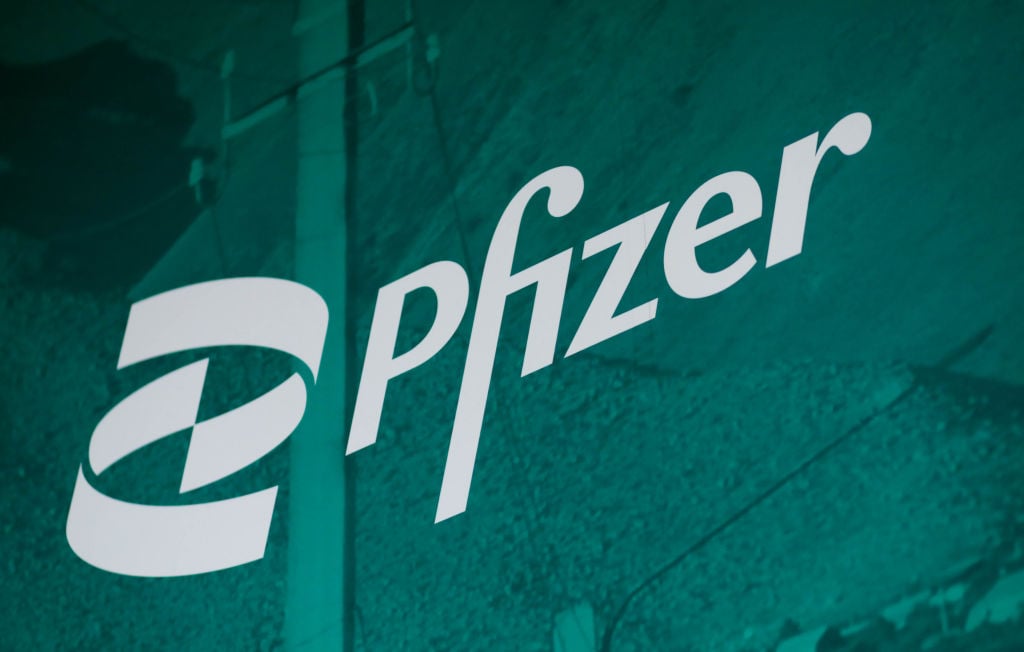
Source: Bristol-Myers Squibb.
The largest pharmaceutical company in the world, Pfizer (PFE 0.28%), is a fixture in a number of retirement portfolios, and it's a staple holding of income investors looking for exposure to the healthcare sector. It's no secret why: Pfizer has a well-diversified portfolio of pharmaceuticals products that tend to perform well in robust as well as recessionary environments.
However, there's one big problem with Pfizer: It's currently suffering from a monstrous patent cliff whereby some of its key drugs are losing their exclusivity and being exposed to generic competition, which costs just a fraction of what branded drugs usually run. The result has been years of stagnant growth.
In the wake of these patent losses -- which include cholesterol-fighting drug Lipitor and now anti-inflammatory Celebrex as of this month -- Pfizer has been trimming its expenses and repurchasing its stock in an effort to boost EPS. Based on Wall Street's estimates, Pfizer's EPS should grow by 9% between 2013 and 2017, which isn't too shabby, all things considered.
But the truth is, you could do so much better. There are three pharmaceutical giants growing considerably faster than Pfizer right now, and I'd opine that all three are attractively valued relative to Pfizer. Let's take a closer look at these pharma giants.
1. Biogen Idec (BIIB 2.45%)
Biogen Idec's growth throughout the remainder of the decade will be fueled by its lineup of multiple sclerosis drugs, as well as the potential behind experimental Alzheimer's disease drug BIIB037.

Source: Biogen Idec.
Without question, Tecfidera is an MS-treating monster drug that's demonstated a very favorable safety profile compared to its peers. Through the first nine months of 2014, Tecfidera has generated $1.99 billion in sales compared to $0.48 billion at this time last year. I'd suggest that $5 billion in peak sales isn't out of the question.
Experimental Alzheimer's drug BIIB037 could be critical as well. It was recently shown to have improved cognition in early-stage Alzheimer's patients in a phase 1 study. The drug has been rapidly moved into phase 3 trials, and if approved, it would likely have an extended shelf life considering how few Alzheimer's drugs are on the market and succeed in large-scale clinical studies.
As a wild card, don't forget about Biogen's hemophilia drugs Eloctate and Alprolix, which were both approved this year. They could each become blockbuster drugs as well.
Between 2013 and 2017, Biogen Idec's EPS is expected to grow by a whopping 161% to more than $23 per share.
2. Bristol-Myers Squibb (BMY 0.15%)
Pharmaceutical giant Bristol-Myers Squibb is also dealing with its own patent cliff woes, but it has one source of growth that should allow it to push past Pfizer: oncology drugs.

Source: Bristol-Myers Squibb.
Bristol-Myers has an exciting class of cancer immunotherapy products designed to enhance the body's immune system so it can better recognize and attack cancer cells. Melanoma drugs Yervoy and Opdivo are great examples of what Bristol-Myers has been able to accomplish in recent years. But, these immunotherapies could hold a number of indications well beyond melanoma. Any tough-to-treat solid tumor cancer, such as non-small cell lung cancer, may respond well to Bristol-Myers' cancer immunotherapies.
In the latest quarter, Yervoy sales roared higher by 47% year over year to $350 million. At this rate, Yervoy is pacing about $1.4 billion in sales and could realistically near $2 billion in annual sales next year.
With a keen focus on fighting cancer, Bristol-Myers is forecast to grow its EPS by 52% between 2013 and 2017.
3. Gilead Sciences (GILD 0.48%)
Though Gilead Sciences probably needs little introduction these days, the three-headed monster that'll lead its growth in the coming decade are oral hepatitis C drugs Sovaldi and Harvoni, and HIV-1 four in one drug Stribild.

Source: Gilead Sciences.
Sovaldi, which treats HCV genotypes 2 and 3 without the need for interferon, and Harvoni, a cocktail blend of Sovaldi and ledipasvir that focuses on genotype 1 patients with no need for interferon or a ribavirin, are big steps forward in patient care. Even as recently as 2011, the standard of care for HCV patients was interferon and a ribavirin, which made people feel like they had the flu and was only effective in eliminating detectable levels of the disease about half the time. Now, Sovaldi and Harvoni typically return sustained virologic responses of 90% or better, and do so in eight to 24 weeks (a shorter time frame).
In its first year, Sovaldi is on pace to deliver in excess of $10 billion in sales, making it the fastest-growing drug in history. Harvoni may wind up breaking that record!
Stribild, on the other hand, is a four-in-one in-house drug designed to replace Atripla. Atripla is the prior-generation HIV maintenance therapy designed to slow the diseases progression. It's comprised of three compounds from three different pharmaceutical companies, meaning revenue and profits were shared three ways. With Stribild, Gilead gets to keep all of its sales and profits.
Between 2013 and 2017, Gilead's EPS is expected to effectively sextuple to $12 per share.
Ultimately, Pfizer will allow investors to sleep well at night with its beta of just 0.72 (signifying lower volatility than the benchmark S&P 500). However, if investors want a solid chance at outperforming the market (and Pfizer, for that matter), they may want to give these three aforementioned pharma giants a closer look.









